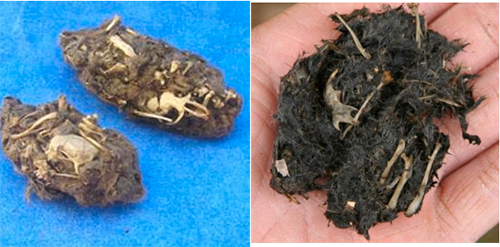Owl Pellet Dissection
Summary
Students dissect owl pellets. After dissection, they sort the bones and glue them onto a picture of a vole skeleton.
Materials
Attachments
- Owl pellets can be purchased from Genesis, Inc. www.pellet.com. Large pellets, catalog # BOP, are $1.70 a piece. One large pellet can be dissected for up to 4 students. Make sure you buy pellets that are sterilized.
- paper plates
- toothpicks
- forceps or tweezers (optional)
- white liquid glue - works better than glue sticks.
- diagram of a vole skeleton provided with the pellets
- Vole Skeleton Chart
Background for Teachers
Owls are birds of prey. They eat rodents, birds and large insects. Since they don't have teeth to chew their prey - they swallow it whole. Owls cannot digest the bones, fur, teeth, feathers or hard insect parts of their prey. These parts collect in their gizzard, a storage area in their stomach. Their stomach muscles form these parts into a ball which the owls eventually spit out.
An owl usually regurgitates its owl pellet within 20 hours of eating its meal (which may consist of more than one animal). The owl cannot eat again until the pellet is regurgitated. Owls are crucial to our environment because they keep the rodent population under control.

Caution: Some students with severe animal fur allergies may get itchy, watery eyes or a runny nose. Ask students before beginning if they have allergies to animal fur. If it bothers them, have them wash their hands and face and stop the dissection.
Intended Learning Outcomes
- Conducting investigations. Collecting data.
- Developing social interactions with peers.
Instructional Procedures
Attachments
Pre-lab discussion: Explain to students how owls are birds of prey and have pictures of several owls to show them. Discuss what an owl pellet is and how an owl forms one. Discuss how the formation of an owl pellet is a biological process that allows the owl to meet its basic needs.
Instructional procedure:
- Place the owl pellet onto a paper plate. Split the pellet between 2 -- 4 students depending on the size of the pellet. Gently pull apart the pellet using forceps, toothpicks and fingers. The students need to be careful so they don't break the bones in the pellet.
- When the pellet is dissected, try and put the bones in groups according to the Vole Skeleton diagram; for example skulls, pelvis' etc.
- Have students share their bones with the other students at their table until most of the students have most of the bones. There will only be one or two skulls for each pellet so these are typically the most desirable bones. Verbally reward sharing.
- Have the students glue their bones onto the Vole Skeleton diagram. Any extra bones they want to keep can be glued on the edges.
- Make sure students wash their hands with soap and water. Wash all tables or desks down as well.
Bibliography
Rio Tinto Hands-on Science Curriculum Team
- Ms. Rae Louie -- Administrator, Principal Beacon Heights Elementary
- Emily Mortensen -- Grant writer, teacher outreach, 2nd grade teacher at Beacon Heights Elementary
- Ruth Li -- Curriculum design, K-6 Science Educator at Indian Hills Elementary
- Deirdre Straight -- Curriculum development, K-6 Science Educator at Beacon Heights Elementary
- Tim Rausch -- Website development, Library Media at Beacon Heights Elementary
Updated: 05/09/2022


 UTAH EDUCATION NETWORK
UTAH EDUCATION NETWORK

 Justin
Justin Braxton
Braxton Dani
Dani Kayla
Kayla Katie
Katie Matthew
Matthew Rob
Rob Val
Val
